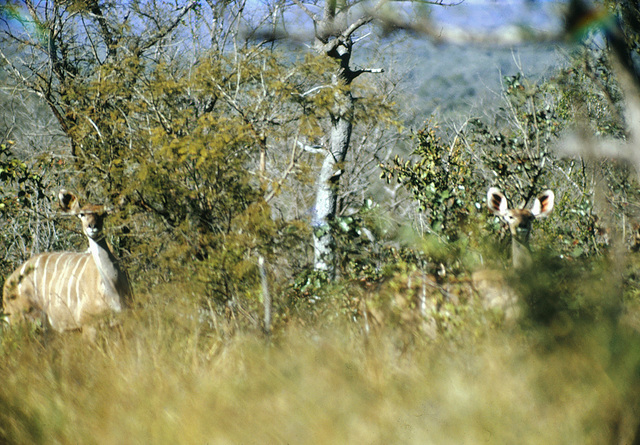Sortelha XIII
Burricada
DSCF7971
Simple chalet staircase - Finland
Gothic
Santarém - III
HFF - Barcelona, Necropole Romana
Peaceful Tejo
Almourol
Almourol - view from the East
Chaves - Hydrothermal springs
Centuries
DSCF0798
Man Made
Guimarães
My friend
HFF
The Douro Valley - Port Wine
Serra da Estrela shepperd dog
DOURO VALLEY - Pinhão, Railroad Station wall
Spring memories
Palace of Mafra - Library
DSCF1128
Igreja de S. Julião
DSCF6240
IMG_0227
Summer
Friends
Waiting
Africa - Water is essential
Caretos 2017
She likes me
Sortelha XIII
Self-Portrait
HFF
DSCF8985
Sortelha XI
DSCF5488
SAVING IPERNITY
Belmonte
Seixal II
Guimarães V
Guimarães IV
help ipernity
IMG_4544
See also...
Keywords
Authorizations, license
-
Visible by: Everyone -
All rights reserved
-
430 visits
Female kudos on the wild.


If you do not look through the right height of the shrubs, you will never see them.
The name of the animal was imported into English in the 18th century from isiXhosa iqhude, via koedoe part zebra part deer.
Kudu, or koodoo, is the Khoikhoi name for this antelope. Tragos (Greek) denotes a he-goat and elaphos (Greek) a deer. Strepho (Greek) means "twist", and strephis is "twisting". Keras (Greek) refers to the horn of the animal.
Lesser kudus come from the savanna near Acacia and Commiphora shrubs. They have to rely on thickets for protection, so they are rarely seen in the open. Their brown and striped pelts help to camouflage them in scrub environments. Scanned from a 1963 Kodhachrome slide.
The name of the animal was imported into English in the 18th century from isiXhosa iqhude, via koedoe part zebra part deer.
Kudu, or koodoo, is the Khoikhoi name for this antelope. Tragos (Greek) denotes a he-goat and elaphos (Greek) a deer. Strepho (Greek) means "twist", and strephis is "twisting". Keras (Greek) refers to the horn of the animal.
Lesser kudus come from the savanna near Acacia and Commiphora shrubs. They have to rely on thickets for protection, so they are rarely seen in the open. Their brown and striped pelts help to camouflage them in scrub environments. Scanned from a 1963 Kodhachrome slide.
Jadviga Grase, Annemarie, Andy Rodker, and 5 other people have particularly liked this photo
- Keyboard shortcuts:
Jump to top
RSS feed- Latest comments - Subscribe to the comment feeds of this photo
- ipernity © 2007-2025
- Help & Contact
|
Club news
|
About ipernity
|
History |
ipernity Club & Prices |
Guide of good conduct
Donate | Group guidelines | Privacy policy | Terms of use | Statutes | In memoria -
Facebook
Twitter

J. Gafarot club has replied to Jaap van 't Veen clubJ. Gafarot club has replied to Marie-claire GalletJ. Gafarot club has replied to Kama 56J. Gafarot club has replied to Xata clubFechando os olhos...seria tudo igual se a memória não nos lembrasse os sacrifícios inúteis.
bon WE José !
J. Gafarot club has replied to @ngélique ❤️ clubYes, they are very elusive. Hope you are having a good weekend.
J. Gafarot club has replied to ╰☆☆June☆☆╮Yes, they are.
You do know things...
J. Gafarot club has replied to Helena FerreiraBoa semana.
Thank you.
Sign-in to write a comment.